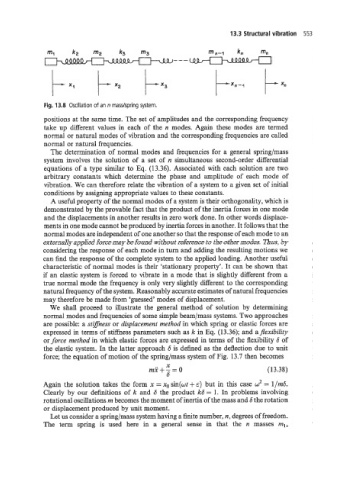Page 572 - Aircraft Stuctures for Engineering Student
P. 572
13.3 Structural vibration 553
Fig. 13.8 Oscillation of an n masdspring system.
positions at the same time. The set of amplitudes and the corresponding frequency
take up different values in each of the n modes. Again these modes are termed
normal or natural modes of vibration and the corresponding frequencies are called
normal or natural frequencies.
The determination of normal modes and frequencies for a general spring/mass
system involves the solution of a set of n simultaneous second-order differential
equations of a type similar to Eq. (13.36). Associated with each solution are two
arbitrary constants which determine the phase and amplitude of each mode of
vibration. We can therefore relate the vibration of a system to a given set of initial
conditions by assigning appropriate values to these constants.
A useful property of the normal modes of a system is their orthogonality, which is
demonstrated by the provable fact that the product of the inertia forces in one mode
and the displacements in another results in zero work done. In other words displace-
ments in one mode cannot be produced by inertia forces in another. It follows that the
normal modes are independent of one another so that the response of each mode to an
externally applied force may be found without reference to the other modes. Thus, by
considering the response of each mode in turn and adding the resulting motions we
can find the response of the complete system to the applied loading. Another useful
characteristic of normal modes is their ‘stationary property’. It can be shown that
if an elastic system is forced to vibrate in a mode that is slightly different from a
true normal mode the frequency is only very slightly different to the corresponding
natural frequency of the system. Reasonably accurate estimates of natural frequencies
may therefore be made from ‘guessed’ modes of displacement.
We shall proceed to illustrate the general method of solution by determining
normal modes and frequencies of some simple beam/mass systems. Two approaches
are possible: a stiyness or displacement method in which spring or elastic forces are
expressed in terms of stiffness parameters such as k in Eq. (13.36); and aflexibility
or force method in which elastic forces are expressed in terms of the flexibility 6 of
the elastic system. In the latter approach 6 is defined as the deflection due to unit
force; the equation of motion of the spring/mass system of Fig. 13.7 then becomes
X
mx+-=O (13.38)
6
Again the solution takes the form x = xo sin(wt + E) but in this case ~3 = l/rnS.
Clearly by our definitions of k and 6 the product k6 = 1. In problems involving
rotational oscillations m becomes the moment of inertia of the mass and S the rotation
or displacement produced by unit moment.
Let us consider a spring/mass system having a finite number, n, degrees of freedom.
The term spring is used here in a general sense in that the n masses ml,

